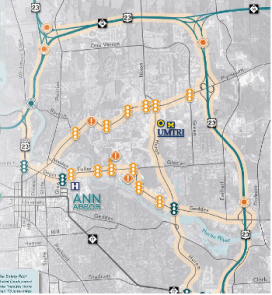Vehicle-to-Vehicle Pilot Test to Determine Safety Benefits
According to the official blog of the U.S. Secretary of Transportation, FastLane, connected vehicle technology could prevent or reduce the severity of up to 80 percent of all crashes involving non-impaired drivers.
Volpe is providing independent evaluation, extensive data analysis, and technical project management for large-scale testing of vehicle-to-vehicle (V2V) safety technologies that provide driver advisories and warnings of roadway hazards. The pilot test will help determine how drivers use the technologies and how much safer they make driving.
In August 2012, the U.S. Department of Transportation (DOT) and the University of Michigan Transportation Research Institute (UMTRI) launched a year-long field study (called the Safety Pilot Model Deployment) in Ann Arbor, Michigan, involving approximately 3,000 cars. This field study is providing the data to understand how effective connected vehicle safety applications are at reducing crashes and how drivers respond to these technologies in a real-world environment.
Volpe is analyzing the data to help the National Highway Traffic Safety Administration (NHTSA) determine next steps. Volpe staff are conducting three primary analyses.
To identify safety-critical events or near-crash scenarios, Volpe uses an algorithm to extract the data from each of the 3,000 participating vehicles. The Volpe team looks closely at the way drivers behave in these safety-critical events to understand how the technology affects their safety.
Driver acceptance is measured with surveys that assess whether drivers would pay for the devices, and whether drivers are concerned about security and privacy.
Volpe is also reviewing the data to understand the accuracy of the warnings issued to drivers. Each vehicle is equipped with five video cameras that collect information on how drivers interact with safety devices and how they respond when crash warnings are presented.
In mid-February, the first 64 vehicles with integrated devices completed six months of testing and drivers provided feedback about their experience via user-acceptance questionnaires. Sixty-four new drivers became part of the study in early March, and will participate through the remainder of the study. Volpe has been receiving monthly data feeds and staff are moving through the analyses. Volpe engineers have analyzed over two thousand safety critical events.
Several products from different manufacturers needed to interact seamlessly for the pilot to succeed. Volpe staff helped manage the interoperability testing of these devices. The tests were performed in a laboratory, on a test track, and in controlled studies conducted on public roads. The products tested include vehicle awareness devices that transmit location and speed information, aftermarket safety devices, and integrated vehicles. For the driver, these devices provide "do not pass" alerts, warnings that vehicles ahead have stopped suddenly, blind spot and lane change warnings, and intersection movement assist warnings.
U.S. Secretary of Transportation Ray LaHood has compared V2V technology with the development of the seatbelt and the airbag. NHTSA will carefully consider the results of this study that has the potential for advancing road safety.
"Cars talking to each other is the future of motor safety."

U.S. Secretary of Transportation Ray LaHood
Speech at the University of Michigan Transportation Research Institute, August 2012.
